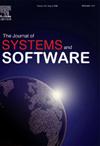FSECAM:将特征与多级软件架构组件联系起来的上下文主题方法
IF 3.7
2区 计算机科学
Q1 COMPUTER SCIENCE, SOFTWARE ENGINEERING
引用次数: 0
摘要
在软件开发和维护过程中,通常会将软件功能与代码组件联系起来,包括实现功能、记录代码、设计测试用例、跟踪需求、跟踪更改以及支持政府和其他第三方对安全关键软件的检查。然而,手动将功能映射到代码既容易出错又耗费时间,即使是熟悉系统的开发人员也不例外。为了克服这些挑战,一些研究提出了自动化技术,以减少将特征链接到代码组件时的人工干预。然而,仍然存在三个挑战:(i) 准确性;(ii) 成本;(iii) 可解释性。链接不相关的代码片段会造成额外的分析负担。如果这种方法缺乏可解释性,那么对于许多关键系统(如安全关键型软件)来说,这种工具的作用就会大打折扣。此外,重量级技术(如需要生成每个场景的执行轨迹或需要训练深度学习模型的技术)成本高昂,限制了小公司将其集成到开发流程中。我们在两个专有项目中进行的实验表明,在将特征与代码组件的三种抽象概念(即模块、类和方法)联系起来时,性能得到了显著提高(在理想情况下,精确度和 F1 分数均超过 50%)。我们的方法还能将提交与问题联系起来,效果很好。上下文主题提取增强了主观可解释性,而现有方法尚未解决这一问题。此外,我们还提取了特征文档和代码结构的几个关键特征,这些特征在人工和自动化技术中都很重要。最后,我们介绍了用于将特征链接到代码组件的 FSECAM 工具,该工具可在开发过程中立即部署和使用,无需在链接代码组件和提交方面花费太多精力和成本。本文章由计算机程序翻译,如有差异,请以英文原文为准。
FSECAM: A contextual thematic approach for linking feature to multi-level software architectural components
Linking software features to code components is commonly performed during software development and maintenance, including to implement a feature, document code, design test cases, trace requirements, track changes, and support inspection of safety–critical software by government and other third parties. However, manually mapping features to code is error-prone and time consuming, even for developers familiar with a system. To overcome these challenges several studies proposed automated techniques to reduce human intervention when linking features to code components. Nonetheless, three challenges remain: (i) accuracy, (ii) cost, and (iii) explainability. Linking of irrelevant code snippets causes an extra burden of analyses. If the approach lacks explainability, then a tool is less useful for many crucial systems such as safety–critical software. Moreover, heavyweight techniques such as those that require generating execution traces of every scenario or require training deep-learning models are costly and limit small companies from integrating them into their development process.
We propose a contextual thematic approach that extracts the most relevant theme properties of the feature/requirement to address the aforementioned challenges. Our experiments with two proprietary projects reveal significant enhancement of performance (precision and F1 scores are more than 50% in ideal cases) in linking features to three abstractions of code components, i.e., modules, classes, and methods. Our approach is also capable of linking commits to issues in a promising way. Contextual theme extraction enhances the subjective explainability which has not yet been solved with existing approaches. Moreover, we extract several critical characteristics of the feature documents and code structures that are important to consider in both manual and automated techniques. Finally, we present the FSECAM tool for linking features to code components, which can be immediately deployed within the development process and used without much effort and cost in linking code components and commits.
Editor’s note: Open Science material was validated by the Journal of Systems and Software Open Science Board.
求助全文
通过发布文献求助,成功后即可免费获取论文全文。
去求助
来源期刊

Journal of Systems and Software
工程技术-计算机:理论方法
CiteScore
8.60
自引率
5.70%
发文量
193
审稿时长
16 weeks
期刊介绍:
The Journal of Systems and Software publishes papers covering all aspects of software engineering and related hardware-software-systems issues. All articles should include a validation of the idea presented, e.g. through case studies, experiments, or systematic comparisons with other approaches already in practice. Topics of interest include, but are not limited to:
• Methods and tools for, and empirical studies on, software requirements, design, architecture, verification and validation, maintenance and evolution
• Agile, model-driven, service-oriented, open source and global software development
• Approaches for mobile, multiprocessing, real-time, distributed, cloud-based, dependable and virtualized systems
• Human factors and management concerns of software development
• Data management and big data issues of software systems
• Metrics and evaluation, data mining of software development resources
• Business and economic aspects of software development processes
The journal welcomes state-of-the-art surveys and reports of practical experience for all of these topics.
 求助内容:
求助内容: 应助结果提醒方式:
应助结果提醒方式:


